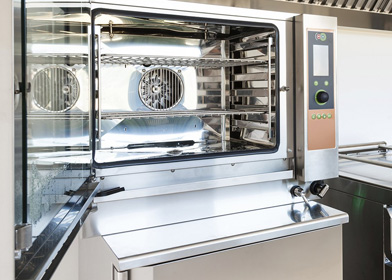
Energy Efficiency in the Kitchen
It’s no surprise that commercial kitchens consume a greater amount of energy than most other types of commercial buildings. Upgrading individual kitchen equipment with more energy efficient options can increase your bottom line. It also has the potential to provide additional, non-energy benefits, including improved performance and better overall cooking results. As a leader in the foodservice industry, with more than 90 years of experience, Boelter has been offering and promoting energy efficient equipment to provide savings to our customers and assisting them to help receive the various equipment rebates wherever available.
Boelter recently had the opportunity to speak with Ann Lovcik, Foodservice Energy Efficiency Consultant at CenterPoint Energy, to discuss the importance of efficiency and energy savings in the foodservice industry and how rebates play a role.
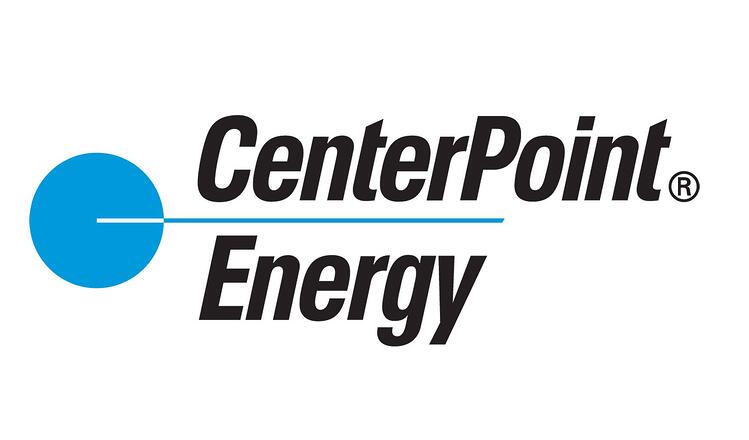
What are some of the primary environmental goals when it comes to energy efficiency? CenterPoint Energy is committed to a clean energy future, with industry-leading carbon reduction goals that include net-zero direct emissions by 2035 and a 20-30 percent reduction in end-use customer emissions by 2035.
It is exciting to know that there are natural gas options in Renewable Natural Gas (RNG), Green Hydrogen and Carbon Capture utilization technology. CenterPoint Energy is offering the RNG interconnection tariff option for its producers and working to get the approval of the green RNG tariff for its customers. CenterPoint Energy is also currently working on pilot projects to showcase the green hydrogen and carbon capture utilization technologies.
As of 2021, 7 of our 8 states (Arkansas, Indiana, Minnesota, Mississippi, Ohio, Oklahoma and Texas) offer conservation improvement programs with individual energy savings goals and rebates for commercial foodservice equipment. The 2021 Minnesota Foodservice goal is to conserve 60,527 Dekatherms (Dth, a unit of heat energy equal to 1,000,000 British thermal units, or BTU) saved through processed customer rebates.
Why should foodservice operators be aware of energy efficiency in their kitchens? According to Energy Star, restaurants use 5-10 times more energy per square footage than any other commercial building. Foodservice operators are using energy year-round and long hours, thus a very high intensity of energy use. As a utility, we have been actively involved in the commercial foodservice industry providing benefits and resources to help conserve natural gas when purchasing and operating high efficiency equipment.
How would you define Energy Efficiency specific to the foodservice industry?
Energy Efficiency in foodservice is using less energy to create a higher volume of product output without compromising quality. With more efficient burner systems and heat recovery designs, many models run equipment with a lower btu input/hour as well as reduce the energy use when in idle mode, which can be 60 percent or more of the time. In fryers, as an example, the high efficiency models recover to the set heat temperatures faster with less energy lost up the flue. Better insulated oven cavities assist in retaining heat to cook product in less time and at lower temperatures. Bottom line is less energy in, faster cook times and higher volume with increased quality!
What are some energy savings programs that are available to foodservice operators? Equipment rebates are a wonderful tool for customers to lower their initial purchasing price, speeding up their return on investment. Utility rebates have grown across the country and many large energy providers offer customer rebates to help offset the initial cost of the more expensive, high efficiency equipment. For example, in 2020, Boelter's Minnesota office worked with CenterPoint Energy MN, submitting customer rebate applications for high-efficiency natural gas foodservice equipment equaling an annual savings of 10,738 Dth, which is equivalent to the average natural gas used in 126 residential homes in one year. *rebates and programs vary from state to state
In addition to the lower purchasing price of the equipment, customers will appreciate the month-to-month operating savings with high efficiency equipment for the life of the equipment. Because of the faster recovery times in many high efficient designs, more product is cooked in less time, allowing operators to serve more meals per hour, at a higher quality, increasing their profits.
How do these programs translate into a reduction in overall operating costs and better savings? CenterPoint Energy MN has developed operating cost comparison charts for customers and trade allies, demonstrating the month-to-month lower energy costs with natural gas equipment. In MN, natural gas can be 50 percent less to operate over equivalent electric models, or more in many cases!
Here are a few cost comparison charts using MN energy costs:
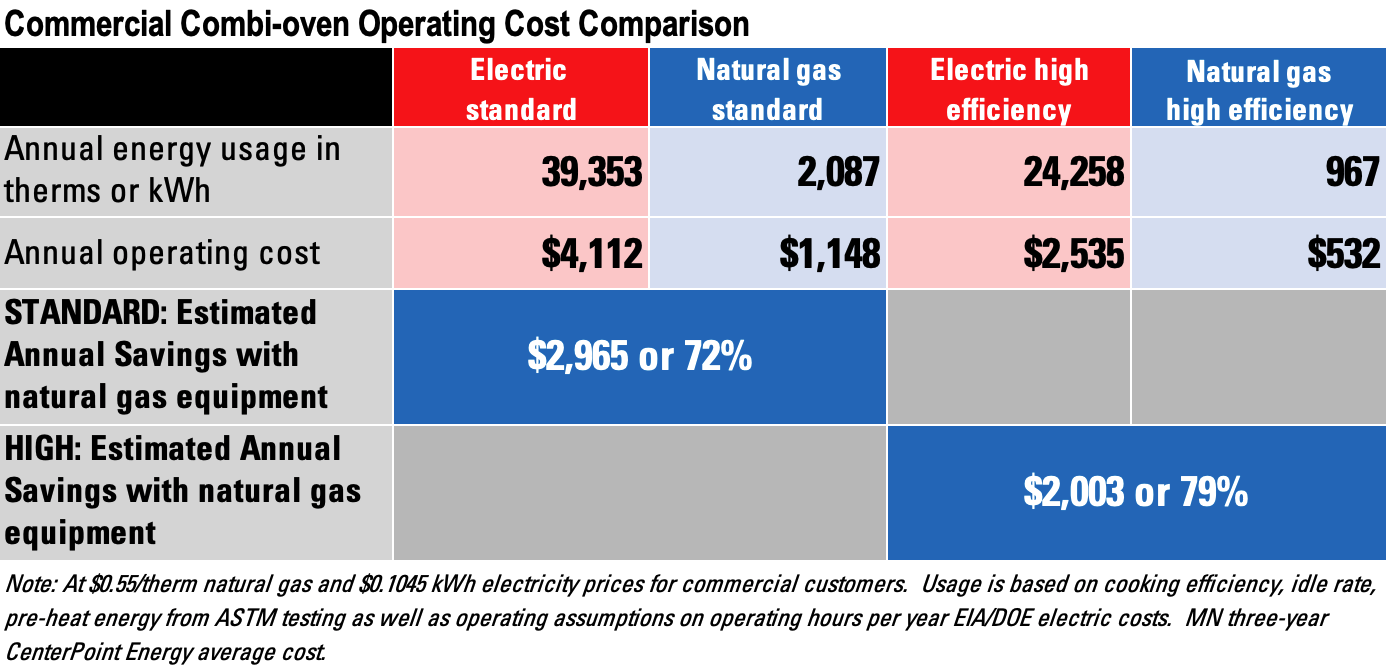

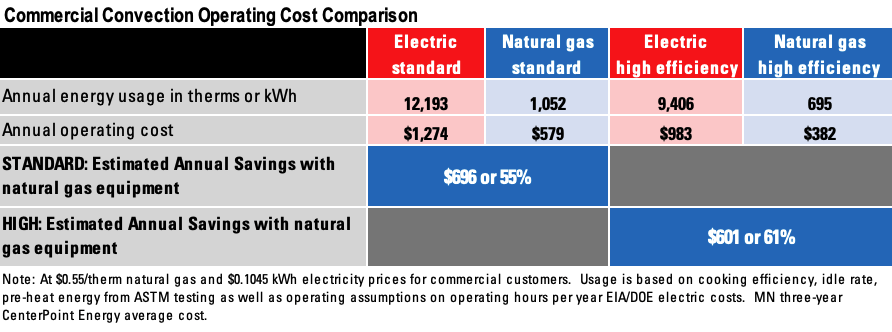
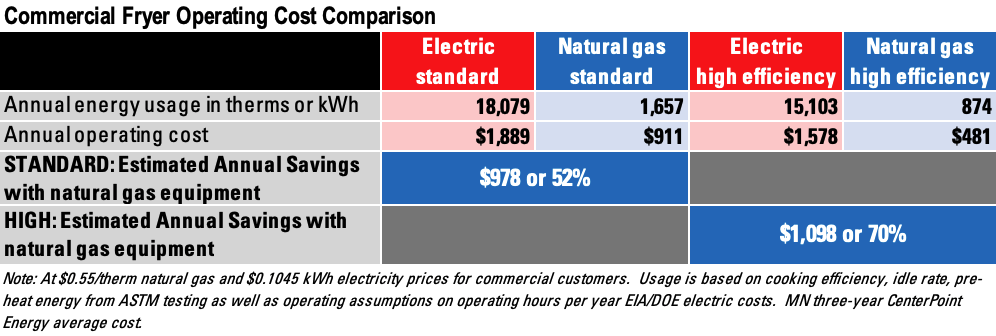
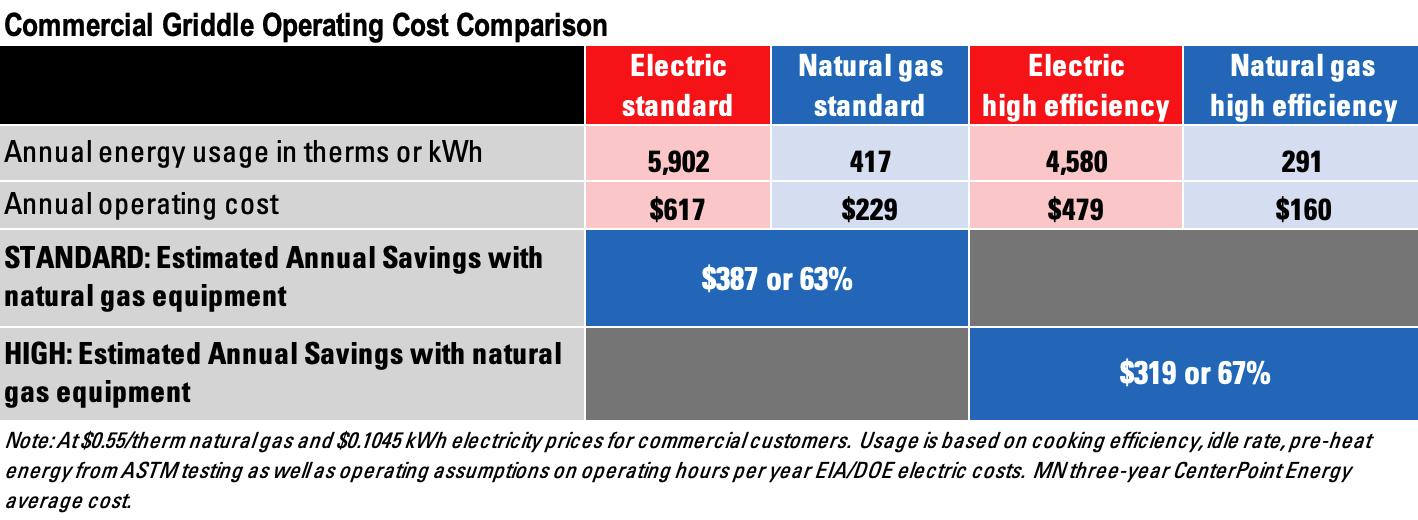
What are some recent advances in foodservice technology that focus on energy efficiency? Natural gas fryers have been improving in their design for years by retaining the heat inside the cooking vat for longer periods of time which provides faster recovery times with less oil being absorbed by the product. More fries per hour!
Combi ovens have been increasing in popularity because they are so versatile – 3 distinct cooking functions in one cavity, reducing the footprint needing ventilation. To have one oven that can low temp steam as well as high temp grill or fry in multiple, pre-set programs, opens up the chef’s menu options. Because of the venting capability, moisture from product can be pulled out of the cavity, allowing items to crisp up nicely! The high-volume opportunity in these ovens frees up staff for other responsibilities, ultimately reducing labor. Many of these ovens have a self-clean feature – dial-in level of cleaning needed and walk away. As you arrive in the morning, the unit is beautifully cleaned and ready to go another day!
Conveyor ovens with sensors on the belts save energy by reducing or shutting down the heated cavity when no product is being cooked, reducing the energy costs by approximately 25 percent.
Dishwashers that meet the Energy Star tested criteria recirculate the hot water inside the unit which lowers the call for outside hot water from a water heater or boiler.
Multi-zone griddles allow operators to vary temperatures by zones or turning off sections when not in use, all reducing the energy.
HVAC is known for being the 2nd largest energy consumer in a commercial kitchen, next only to food preparation. The energy used to exhaust and replace air into the kitchen typically is designed as if all the equipment under the hood was being used when many times, some pieces of equipment are in idle mode, waiting for product to cook. By code, when outside air is 50 degrees or colder, you are required to heat that air coming back into the kitchen. Most make up air units in the northern states are heated by natural gas because of the lower operating costs.
Newer kitchen hood technology applies sensors to the system which automatically adjust up or down the exhaust and make up air flow, saving 20-50 percent energy for the operator without doing a thing.
If you are a foodservice operator – new to the industry or one considering equipment updates – what options are available when it comes to learning about and choosing energy saving equipment for their kitchen? There are many decisions and options for any operator in foodservice. Which energy fuel should I use? Which equipment type should I purchase? Do I want to invest long term with high-efficient equipment or purchase more often the standard pieces? In MN, natural gas pricing is at least 50 percent less to operate than electricity, and in some cases up to 79 percent savings with natural gas. CenterPoint Energy MN, along with other utilities across the US, offer Demonstration Kitchens at NO CHARGE to end user customers. In our MN Foodservice Learning Center, we provide a NEUTRAL site, working with all brands and types of equipment. Take advantage of these ‘Try Before You Buy’ facilities to verify you are making the best decision for your menu and volume.

Ann Lovcik brings 19 years of expertise working with commercial foodservice operators, dealers, distributors, consultants, and manufacturer's representatives - promoting energy efficient natural gas foodservice equipment. Ann manages the unique CenterPoint Energy Foodservice Learning Center in Minneapolis, conducting equipment training and overseeing demonstrations and industry seminars.
She serves on the leadership team of the national Energy Solutions Center Blue Flame Alliance (BFA) Consortium, holds a Bachelor of Science of Psychology from University of Northwestern, St Paul, MN, and retains certifications as a NAFEM Commercial Foodservice Professional (CFSP) and with ServSafe.
Additional information about CenterPoint Energy and Energy Foodservice Rebate Programs:
- CenterPoint Energy National Accounts
- CenterPoint Energy Rebate Programs
- CenterPoint Energy Commercial High-Efficiency Foodservice (CHEF) Program
Work with your local municipality to obtain the most up-to-date and accurate rebate programs available. Get in touch with a Boelter expert today to help you with that process.